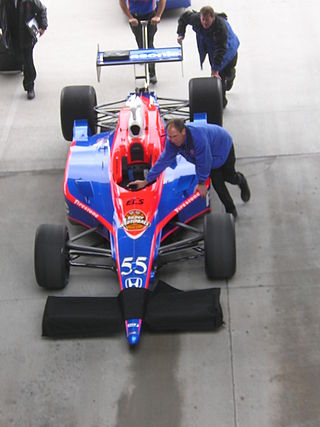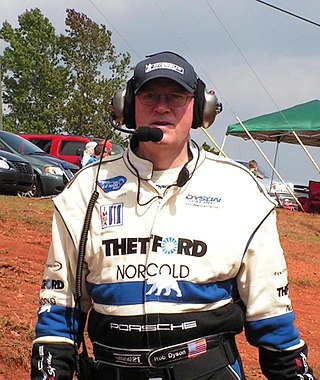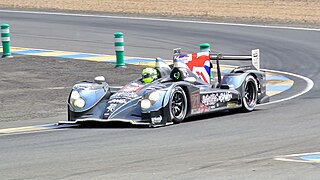
Guy James Mutlow Smith is a British professional racing driver and IB English teacher and coordinator in Brazil, who has competed in various levels of motorsport, most notably the 24 Hours of Le Mans, which he won in 2003, and the American Le Mans Series, which he won in 2011.
John Lee Paul Jr. was an American racing driver. He competed in CART and the Indy Racing League competitions, but primarily in IMSA GT Championship, winning the title in 1982.

Fernández Racing was a Mexican motor racing team that competed in the American Le Mans Series, Champ Car, the IRL IndyCar Series, and the Rolex Sports Car Series. The team was co-founded by Adrian Fernández and Tom Anderson in 2001.

Robert Franklin "Butch" Leitzinger is an American professional racing driver. He is best known as an ALMS driver with Dyson Racing, but he has also driven for a variety of other teams and race series. He won the IMSA Pro WSC Ckampionship driver's titles in both 1997 and 1998 while driving for Dyson Racing. Also a three time winner of the Daytona 24 hours race in 1994, 1997 and 1999.
The 2006 American Le Mans Series season was the 36th season for the IMSA GT Championship, with the eighth as the American Le Mans Series. It was a series for Le Mans Prototypes (LMP) and Grand Touring (GT) race cars divided into 4 classes: LMP1, LMP2, GT1, and GT2. It began March 18, 2006, and ended October 21, 2006 after 10 races.

The 2004 Toronto Grand Prix of Mosport was an American Le Mans Series professional sports car race held at Mosport International Raceway near Bowmanville, Ontario, Canada from August 6 to the 8, 2004. It was the sixth race of the 2004 American Le Mans Series season and the 19th IMSA sanctioned sports car race held at the facility.
Advanced Engine Research, Ltd. is an auto racing engine manufacturer based in Basildon, Essex, England. Established in 1997, AER has developed winning engines for a number of high-profile international race series in sports car, prototype racing, rallying, touring car, and open wheel racing. They have designed engines derived from road car platforms, but their emphasis is on clean sheet designed engines with a focus on electronics and turbochargers. Their engines have raced in the 24 Hours of Le Mans, the World Endurance Championship (WEC), the European Le Mans Series (ELMS), the United SportsCar Championship (TUSC), GP3, British Touring Car Championship (BTCC), Nissan/Renault World Series, Grand-Am, Paris Dakar and FIA Sportscar Championship. They have worked with a number of manufacturers including Mazda, Ford, Hyundai, MG/Rover, Nissan, and Toyota. In 2012, AER developed and built Formula One turbo test engines to current rules and in July 2012, AER was chosen as engine partner and supplier to the new GP3 racing series. They currently supply engines for the Indy Lights series.

The Acura ARX-01, later known as the HPD ARX-01 is a series of Le Mans Prototype built for sports car racing, specifically in the American Le Mans Series, Le Mans Series, and at the 24 Hours of Le Mans. It is the first purpose-built race car by the Acura division of Honda Motor Company, part of their multi-year program to eventually compete in endurance race. The car debuted in 2007 in the American Le mans Series before expanding to customers in Europe. Over the years various specifications of the ARX-01 chassis have been developed, each signified by a letter suffix. In 2010 Acura withdrew their name from the program and Honda Performance Development which developed the car for Acura continued the program into 2011.
Highcroft Racing was an American auto racing team based out of Danbury, Connecticut and founded by driver Duncan Dayton in 1989. Initially founded for Dayton's involvement in historic motorsport, specifically the restoration and preparation of classic automobiles, the team was expanded for Dayton's entry into the USAC Formula Ford 2000 series in 1994. The team entered a partnership with Intersport Racing in 2003 and entered the American Le Mans Series (ALMS).

The 2009 American Le Mans Series season was the 39th season for the IMSA GT Championship, with it being the eleventh season with the American Le Mans Series moniker. It began on March 21, 2009, and ended on October 10, 2009 after ten events. The series was composed of Le Mans Prototypes (LMP) and Grand Tourer (GT) race cars divided into four classes: LMP1, LMP2, GT1, and GT2. A fifth category, known as the Challenge class, was also added for select races and featured Porsche 997 GT3 Cup cars from the IMSA GT3 Cup Challenge. 2009 was also the final year for GT1, with Corvette Racing abandoning the class after Long Beach and switching over to much more competitive GT2 class.

The 2009 Mobil 1 12 Hours of Sebring was the 57th running of the 12 Hours of Sebring and the opening round of the 2009 American Le Mans Series season. It took place at the Sebring International Raceway, Florida on March 21, 2009. Three new cars made their debut at Sebring: Audi's diesel R15 TDI, Acura's first LMP1 entry the ARX-02a, and the return of the BMW M3 to the GT2 category. It was also the last time GT1 category raced at the event.
The 2010 American Le Mans Series season was the 40th overall season for the IMSA GT Championship, and the twelfth as the American Le Mans Series presented by Tequila Patrón. It was also the first season in which the ALMS used a revised structure for its four classes, as well as the first year in a three-year sponsorship deal with Patrón. The season began with the 12 Hours of Sebring on March 20 and ended with the Petit Le Mans on October 2, completing nine total races.

Robert Richard "Rob" Dyson is a retired American sports car racing driver and owner of Dyson Racing.
The 2011 American Le Mans Series season was a multi-event motor racing series for sports racing cars which conform to the technical regulations laid out by the International Motor Sports Association for the American Le Mans Series. It was the thirteenth season of the American Le Mans Series, a sports car racing series that drew original inspiration from the types of racing cars that compete in the 24 Hours of Le Mans, and the 41st season for the IMSA GT Championship, as this series traces its lineage to the 1971 IMSA GT Championship. The full title of the 2011 series is "the American Le Mans Series presented by Tequila Patrón" to include the principal sponsor. The season began March 19, 2011 with the 12 Hours of Sebring and ended after nine rounds on October 1 with the Petit Le Mans.
Muscle Milk Pickett Racing was a motorsports group from Indianapolis, Indiana. The team was founded in 2007 by CytoSport co-founder and former IMSA GT Championship driver Greg Pickett. Since 2007, Pickett's team has competed in the United SportsCar Championship, the American Le Mans Series, the 24 Hours of Le Mans and the IMSA GT3 Cup Challenge. The team officially closed in 2014.

Christopher Dyson is an American professional racing driver who competed in the American Le Mans Series for Dyson Racing from 2002 to 2013. He is currently competing in the Trans-Am Series in the TA class under the CD Racing banner where he just clinched his third consecutive TA championship (2021-2023). The son of team owner Rob Dyson, Chris is a two-time ALMS champion, having taken the LMP675 Drivers title in 2003 and earning the LMP1 Championship in 2011. He is the Vice President and Sporting Director of Dyson Racing.

The HPD ARX-03a, ARX-03b, and ARX-03c are Le Mans Prototypes race cars developed by Honda Performance Development in 2012. The 03a model utilizes a Honda V8 engine for use in the LMP1 category, while the 03b uses a turbocharged V6 engine for the LMP2 category. Three teams have already announced their use of the ARX-03 in the FIA World Endurance Championship and the American Le Mans Series, as well as at the 24 Hours of Le Mans. Muscle Milk Pickett Racing have purchased an 03a for use in the American Le Mans Series, joined by two 03bs for Level 5 Motorsports. In the 2014 FIA World Endurance Championship, Strakka Racing and JRM Racing campaigned a single 03a each, joined by a single-car 03b entry by Starworks Motorsport in LMP2.

The 60th Annual Mobil 1 Twelve Hours of Sebring was an 12-hour automobile endurance race for teams of three drivers each fielding sports prototype and grand touring cars held on March 17, 2012 at the Sebring International Raceway in Sebring, Florida before more than 90,000 spectators. It was the 60th 12 Hours of Sebring and the first round of both the 2012 FIA World Endurance Championship (WEC) and the 2012 American Le Mans Series (ALMS). Le Mans Prototype 1 (LMP1), Le Mans Prototype 2 (LMP2), Le Mans Prototype Challenge (LMPC), Le Mans Grand Touring Endurance (LMGTE), and Grand Touring Challenge (GTC) cars competed in the race.

Champion Racing was a sports car racing team based in Pompano Beach, Florida, USA. Founded in 1994 by Dave Maraj, a former rally driver from Trinidad, as the motorsport wing of the Champion Motors car dealership, the team has campaigned various Porsches and Audis in North American road racing series. Champion Racing's extensive record includes a win at the prestigious 24 Hours of Le Mans in 2005, and 5 straight American Le Mans Series LMP1 championships, 2 as a private team and 3 as a factory team under the name Audi Sport North America.
Intersport Racing is a former American auto racing team founded by Jon Field. The team was based in Dublin, Ohio. They previously operated two Oreca FLM09 sports cars in the American Le Mans Series. At current, the company has transitioned into diet supplements.















